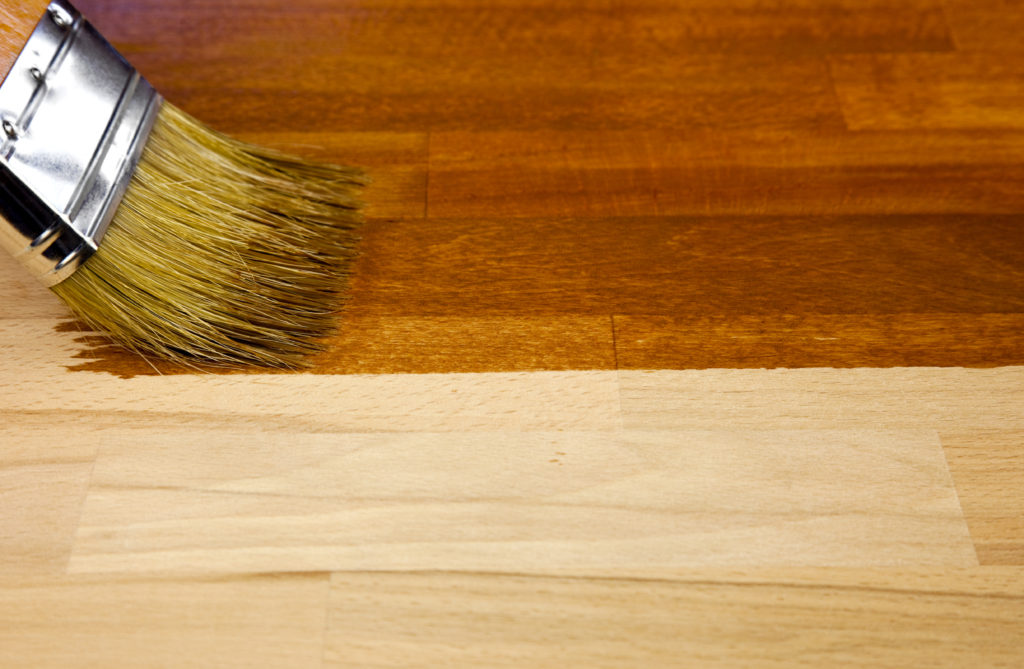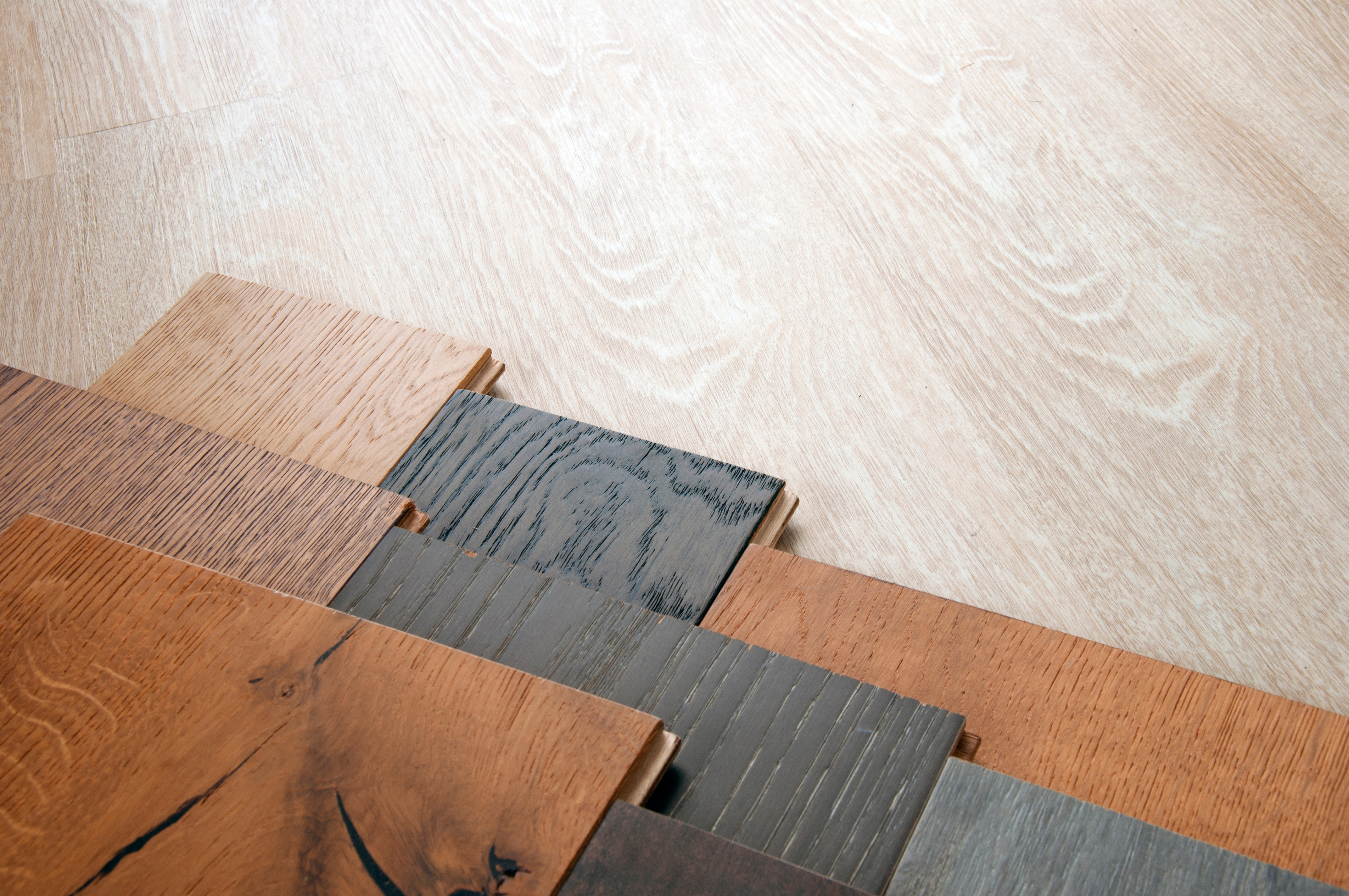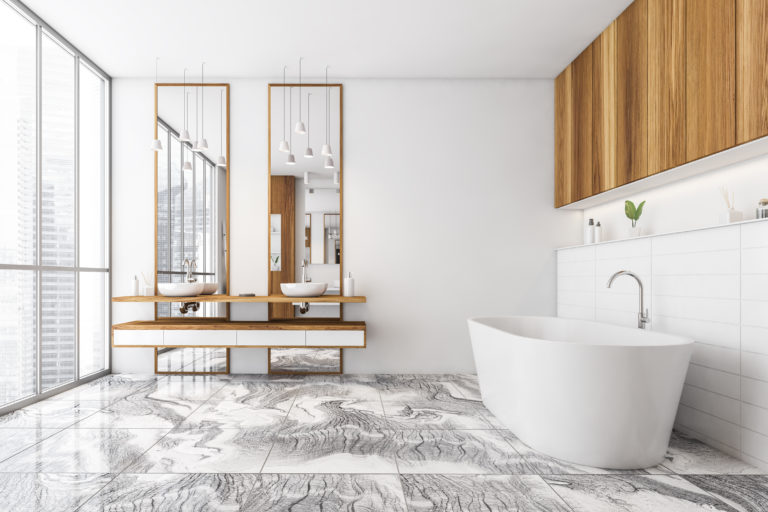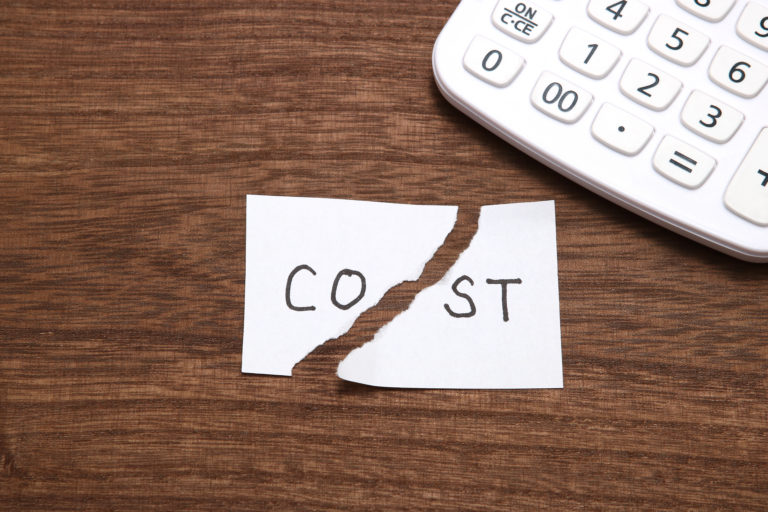This post may contain references or links to products from one or more partners of our parent company and/or subsidiaries of our parent company. For more information, visit this page.
Updated October 20, 2021
Trying to decide between prefinished hardwood flooring and unfinished hardwood flooring?
We understand—hardwood is beautiful, timeless, and one of the most popular types of flooring around.
But putting in unfinished hardwood floors and finishing them in your home can fill your house with dust and debris while taking weeks to complete.
That’s why these days, most people opt for prefinished hardwood flooring—hardwood planks that come with stain and sealant already applied. Often, they offer an easier, quicker way to get the warmth of hardwood floors.
However, prefinished wood may offer less customization than unfinished wood—especially when it comes to specialty wood flooring types.
So: is prefinished hardwood flooring right for you? Are prefinished hardwood floors better than finished-on-site hardwood floors? We’re here to help you find out.
Below, we’ll take you through all the basics of prefinished hardwood flooring. We’ll talk about its pros and cons, answer some frequently asked questions, compare prices to unfinished hardwood, and more.
Let’s get started!
First of All: What Exactly Is Prefinished Hardwood Flooring?
Prefinished hardwood flooring is exactly what it sounds like—real hardwood planks that are pre-finished with stain and sealant before they arrive at your door.
They can be made from any hardwood species, and they’re often sealed with a super-hard aluminum oxide coating to make them durable and scratch-resistant.
These days, many (if not all) of the best hardwood floor brands offer prefinished hardwood in a wide range of stains, finishes, and sizes.
Best Brands of 2024
Prefinished Hardwood Flooring vs. Engineered Wood Flooring: What’s the Difference?
We hear this question a lot, and we want to clear it up before we talk about anything else. All the best engineered wood flooring can either come pre-finished or unfinished. The finish has nothing to do with the wood being engineered or solid.
The real question you should be asking is what’s the difference between prefinished hardwood and unfinished hardwood?
Engineered Wood Is a Type of Wood Flooring—Not a Type of Finish
Engineered and solid hardwood are the two main types of wood flooring.
And both of these can be purchased prefinished or unfinished. The only difference is that when you purchase unfinished wood, you have to finish it on-site.
So: what is engineered hardwood and how is it different from solid hardwood? While solid hardwood is one piece of wood throughout, engineered wood combines a high-strength plywood base and a solid wood veneer. It’s not faux wood flooring—it’s just another type of hardwood.
And again, engineered hardwood can come pre-finished or unfinished.
Engineered Wood Flooring Has a Lot Going For It
If you need moisture-resistant flooring, engineered wood might be your best bet. It stands up to changes in heat and humidity much better than solid hardwood does.
Think of it this way: the bigger the wood plank, the more vulnerable it is to cupping and warping. That’s why most wide-plank wood flooring options are made with engineered wood—because it’s much more stable.
Also, engineered wood can cost less when you buy exotic wood species—because it uses less of that precious exotic wood.
Besides regular wood, many of the best bamboo flooring, best cork flooring, and even best hemp flooring options can be purchased in engineered varieties—so you have no shortage of options to choose from.
All of that to say: engineered wood’s disadvantages are small potatoes when considering its upsides.
And Remember: Most Engineered Wood Flooring Options Come Prefinished
While you can buy prefinished or unfinished engineered wood, the majority of your options are going to be pre-finished. That’s not a hard-and-fast rule, it’s just the reality of buying hardwood floors. Don’t worry though—that’s not a bad thing! Here’s why.
Prefinished Hardwood Flooring Pros and Cons
Ok! Now that we’ve talked about the difference between prefinished hardwood and engineered hardwood, let’s talk specifically about the pros and cons of prefinished hardwood floors.
The Advantages of Prefinished Hardwood Flooring
Let’s start with the good stuff! Here are the advantages of buying your hardwood floors pre-finished.
Installing Prefinished Hardwood Flooring is Quick and Clean
The speed and simplicity of installing prefinished wood is one of its biggest advantages. If you’re living in your house during a renovation, you do not want to deal with all the dust and chemicals that come with buying unfinished wood and finishing it on-site. Trust us on that one.
All wood flooring types will add warmth classic style to your home. But prefinished hardwood flooring can be walked on immediately after installation—meaning you don’t have to wait for stains to dry or for sealants to cure!
Prefinished Hardwood Can Be Safer for Your Home…
If you buy prefinished floors, your family won’t spend days breathing in harmful VOCs as your new finish dries.
VOCs, or volatile organic compounds, are harmful chemicals that slowly off-gas from different types of industrial products. Adhesives and finishes are some of the worst offenders. And there’s really no point in looking for low-VOC flooring if you’re going to be breathing in fumes from all the stains and finishes that go on top of them!
Because the VOCs Off-Gas in the Factory—Not Your House
Yep—prefinished flooring can save the day for health-conscious wood-lovers. Sure, you could look into non-toxic laminate flooring or low-VOC vinyl flooring. But if you want low-VOC wood flooring, pre-finished is almost always the way to go.
Plus, if you go with a domestic and renewable wood species like pine or maple, your prefinished hardwood can be environmentally-friendly flooring too! Sounds like a win to us.
Plus, it’s Way More Durable and Wear-Resistant
Prefinished hardwood stands up to wear and tear better than hardwood that’s finished on site.
So if you need scratch-resistant flooring and you’re dead-set on using hardwood—especially in high-traffic areas like entryways or hallways—prefinished wood is probably the way to go. Its durability also makes it some of the best wood flooring for dogs (and for the people who love them).
Prefinished Wood is Usually More Widely-Available Than Unfinished Wood
These days you may find that it’s easier to purchase prefinished wood than unfinished planks, especially at big-box retailers.
From mom-and-pop flooring stores to national home-improvement chains, you’ll most likely have a very good selection of prefinished hardwood flooring in different species and stain finishes near you.
And There Are Endless Options to Choose From
Looking for eco-friendly flooring? Pine flooring? Sustainable wood flooring? Ebony flooring? Teak flooring? Douglas fir flooring? It does not matter—whatever you’re looking for, you can find endless prefinished options.
Our advice: find a top-rated local flooring store near you and ask their opinion about prefinished hardwood. They can tell you about everything from the disadvantages of hickory vs. oak flooring to the common grain patterns ash flooring and everything in between. If you want an expert opinion, they’re the ones to go to!
The Disadvantages of Prefinished Hardwood Flooring
Of course, there are some disadvantages of prefinished hardwood. Here are a few of the most important ones to know about.
Prefinished Hardwood Can’t Be Used for Some Custom Designs
We’re sorry to say, but you may have to forget about your Pinterest folder of intricate wood floor patterns if you choose prefinished hardwood flooring.
Obviously, it depends on what you’re going for. Classic wood floor designs like herringbone and chevron parquet flooring are easily achievable with prefinished hardwood. But when it comes to multi-colored, 3D designs and inlays…well, they’ll probably require a custom finish.
Unfinished Hardwood is Much More Customizable…

This one is a no-brainer, but we’re going to go over it anyway. If you buy unfinished hardwood and finish it on-site, you can literally make it look like anything. Because you’re the one who’s in charge of finishing it!
Including The Way Your Edges Look (Beveled vs. Unbeveled, etc.)
Customization isn’t limited to color and finish, either. It also includes the way the edges of your floor will join together.
Many prefinished hardwood planks have slightly rounded, or beveled, edges. Others have squared edges. It just depends on the product.
We’re going to say it again: most flooring stores offer way more prefinished options than unfinished options. Just keep in mind that you may not be able to fully customize all the aspects of these floors, including the edges.
Prefinished Hardwood Won’t Hide Subflooring Troubles (but Unfinished Hardwood Will)
While prefinished hardwood can do a lot of things, it can’t hide any problems in your subflooring. “What is subflooring?”, you ask? Simple—it’s the foundation of your flooring, often plywood boards nailed down to the big beams holding up your floor.
Unfortunately, prefinished hardwood will make any flaws in your subfloor immediately evident. If your subfloor is uneven in spots, it can cause some of the planks to raise slightly, or even result in visible gaps between the planks.
This means you’d need to create a perfectly flat foundation for the planks to sit on—a challenge that can drive up the cost of your project significantly.
On the other hand, unfinished hardwood that’s finished on-site can be sanded down to a flat, even surface regardless of how the subfloor looks.
And Prefinished Hardwood Flooring Isn’t Necessarily Waterproof
While prefinished hardwood is resistant to scuffs and dents, it’s just as vulnerable to water damage as any other hardwood floor.
So if you’re set on the look and feel of wood for your bathroom or mudroom flooring, we’d still recommend buying a specialty water-resistant wood flooring product like Mohawk’s RevWood.
Alternately, you could always go with a fake wood flooring option—something like wood-look tile, for instance. If your floor is going to encounter moisture, there’s simply no debating tile vs. wood floors—tiles are fully waterproof, while wood is likely to fail after water damage.
And you don’t have to be an expert to DIY tile floors, either. These days, advances like snap-together tile flooring have made it easy to install all types of tile, from natural stone to wood-look porcelain.
The Cost of Prefinished vs. Unfinished Hardwood Flooring
You may have noticed that we haven’t yet talked about pricing. That’s because it’s neither a pro nor a con of prefinished hardwood flooring. Essentially, it boils down to this:
- Prefinished hardwood flooring may cost more to purchase, depending on about a million factors (the wood flooring type, the brand, the finish, your location, the amount you’re buying, etc. etc.) but…
- Unfinished hardwood flooring usually costs more to install, because it has to be finished on-site.
What’s the Average Cost to Install a Prefinished Hardwood Floor?
Again, it depends on a ton of factors. What installation method are you going to use? Nail-down? Glue-down? Floating? There are some disadvantages of floating floors, but they’re generally cheaper and easier to put in.
Whatever the case, the average cost to install engineered hardwood floors—or solid wood floors, for that matter—ranges between $3 and $8 per square foot with prefinished planks. Not quite as low as the cost to install vinyl plank flooring, but definitely cheaper than the cost to finish your hardwood on-site.
PS: if that has you wondering “what’s a floating floor?”, it’s a floor that clicks together and is held in place by friction, rather than being attached to an underlayment or subfloor. And if that has you wondering “what’s the difference between an underlayment vs. a subfloor“…well, just click on that link to read about it.
Prefinished Hardwood Flooring FAQs
Alright! Now that we’ve talked about prices, let’s answer some frequently asked questions about prefinished hardwood flooring.
Can a Prefinished Hardwood Floor Be Refinished?
Absolutely! Remember, a floor coming prefinished or unfinished has nothing to do with the actual type of flooring it is. So if you can refinish the flooring material, that’s the only thing that matters.
Solid hardwood, for example, can be refinished indefinitely—regardless of whether you buy it prefinished or unfinished. Engineered hardwood, on the other hand, can only be refinished a number of times (if at all) due to the thinness of the veneer layer. After all, you could accidentally sand right through it!
The same goes for hardwood floor alternatives. If you can refinish the material, you’re good to go.
Example: you can refinish bamboo flooring, but you can’t refinish vinyl flooring like Pergo Extreme because it’s made of plastic. We know, we know—it’s one of the big disadvantages of vinyl plank flooring.
The point is, the prefinished vs. unfinished hardwood debate has nothing to do with the floor’s ability to be refinished. That’s all about the material, not the finish.
Can You Buy Prefinished Hardwood Flooring in Wide Plank Sizes?
Yes! In fact, you may even have a lot more options, since most wide-plank wood flooring is made of engineered wood. And most engineered wood comes prefinished.
What are the Best Prefinished Hardwood Flooring Brands?
This is an easy one. Almost all the top hardwood brands sell a majority of their wood prefinished. So a better question would be “what are the best unfinished hardwood flooring brands?”
And really, at the end of the day, the best hardwood floors are the ones you like.
Is Cork Flooring Usually Prefinished or Unfinished?
That’s a good question! Cork is technically made of wood bark (pretty cool, right?), but most people think of it as a type of wood flooring. And while you can technically buy cork either prefinished or unfinished, it almost always comes pre-finished.
Why? Well, if you look into pros and cons of cork flooring, you’ll find that one of the biggest disadvantages of cork flooring is its susceptibility to moisture. In fact, most cork products require periodic resealing to keep them from absorbing too much. So if you’re going to buy unfinished cork and finish it on-site, you need to make sure you have a pro doing the job.
PS: beware of the cork flooring Lowes or Home Depot sells. It’s not a particularly high-quality product. And some of the options aren’t actually cork at all.
Does Prefinished Hardwood Flooring Resist Water Better?
It depends on the type of finish! But if water resistance is a priority, you’d be better off weighing the benefits of using linoleum vs. laminate or exploring the best vinyl plank flooring brands. The best types of vinyl flooring are so water-resistant, they can even be used as outdoor flooring options.
Is Prefinished Hardwood Flooring Right for Your Project?
Installing hardwood floors is in an investment in your home, not an expense. No matter your tastes or budget, you can probably find a prefinished hardwood product that makes sense for you.
So: while unfinished hardwood flooring might offer a little more customization, there’s no question that prefinished hardwood flooring is the easier, more common, and quicker option.
Either way, hardwood isn’t the world’s easiest flooring to install (that dubious honor goes to peel-and-stick carpet tiles), so make sure to find a top-rated flooring store near you to get some expert help and expert installation.
And until next time, happy flooring!
Oh, and for more information on different types of floors, check out:
- Carpet vs. Laminate: The *Real* Pros & Cons
- Magnetic Flooring: Everything You Need to Know
- How Much Does it Cost to Replace Carpet With Hardwood?
- Laminate vs. Hardwood Floors: Which are Better?
- Tile vs. Laminate Flooring: The Pros and Cons
- Can You Bleach Wooden Floors? Yes! Here’s How
- Carpet or Hardwood in Bedrooms: Which is Better?
- Hickory Flooring Pros and Cons: The Guide
- The Ultimate Guide to Low-VOC Carpet
- Vinyl Plank vs. Laminate Comparison: Which is Better?
- EVP Flooring: What to Know
- Bamboo Flooring vs. Laminate: Which to Buy?
- Engineered Bamboo Flooring: Pros and Cons
About The Author

Rose Mraz
January 27, 2021
Rose's career has taken her from small-town teacher to mixologist at several award-winning NYC cocktail bars (and everywhere in between). These days, she plies her craft as an SEO writer specializing in the confluence of wellness, politics, and the service industry.






